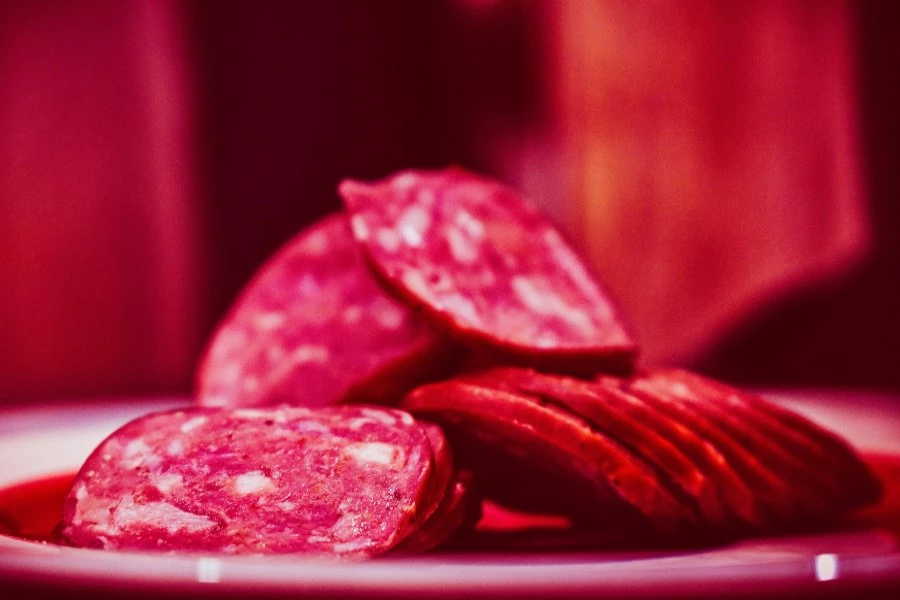Pepperoni is an Italian delicacy that has been around since the early 1900s. “pepperoni” comes from “peperone,” which means bell pepper in Italian.
Pepperoni is a ground meat sausage prepared from pork, beef, or a combination of the two. It’s spicy and has a rich flavor. Pepperoni is usually sliced thin and eaten as part of a pizza.
There are two types of pepperoni sausage – cured or uncured. This article will describe an uncured pepperoni, its merits, and its demerits.
What Is Uncured Pepperoni?
Uncured pepperoni does not contain nitrates, which people use to preserve meat and give it a pinkish coloration; instead, it contains natural preservatives like salt and sugar to help keep it fresh.
Due to the absence of nitrates and preservatives, many people consider uncured pepperoni healthier than the cured variety. It also has a more natural flavor, which some people prefer the cured pepperoni.
However, uncured has a higher salt content due to its natural preservatives, which can be just as hazardous.
Cured Pepperoni
Cured pepperoni is a cured meat made from pork, beef, or both. The meat contains salt, pepper, garlic powder, and sometimes other spices.
Making cured pepperoni starts by selecting the best cuts of meat for curing. Next, mix the beef with salt and spices and keep it in the refrigerator for a few days.
After refrigerating, slice the meat into thin pieces and hang to dry in a properly ventilated area. The last step involves smoking the dried pepperoni slices over wood chips or sawdust until ready.
Similarities Between Cured And Uncured Pepperoni
Cured and uncured forms of pepperoni share some similarities.
- Both forms of pepperoni are often a pig and beef blend.
- Regardless of their misleading titles, both forms of pepperoni have undergone curing.
- You can use cured and uncured pepperoni on pizzas, sandwiches, and pasta.
Differences Between Cured And Uncured Pepperoni
Cured and uncured pepperoni differ in many ways.
- The primary distinction between both types of pepperoni is the curing method. Cured pepperoni contains artificial preservatives, which can negatively impact your health. Uncured pepperoni, however, has no artificial or chemical preservatives.
- Cured pepperoni has a distinct red color, while uncured pepperoni is reddish but milder than cured pepperoni.
- Uncured pepperoni has a light, salty flavor with a lingering but faint spiciness. On the other hand, cured pepperoni is well-known for its flavor, with 99 percent of the flavor coming from the seasoning.
- Uncured pepperoni is more tender and has a milder flavor than cured pepperoni. Cured pepperoni has a stronger flavor and a firmer texture due to the salt added during the curing process.
About Food Curing
Curing is preserving meat by adding salt, sugar, nitrite, and nitrate. Salt can be applied to the food surface, combined dry (dry curing), or dissolved in water (wet or pickle curing).
The latter involves burying the meal buried in brine. It’s also possible to bury larger cuts of beef in brine. In curing, the phrase pickle refers to any sugared brine solution.
Salt suppresses microbial development via plasmolysis. A higher salt concentration outside the cell causes osmosis to pull water out of the microbial cell. A cell loses water until it is unable to grow or survive. The salt required to prevent plasmolysis growth varies depending on the microorganism’s genus and species.
However, most salt cures don’t contain enough salt to preserve meats at room temperatures, so some microbial organisms like Clostridium survive. However, nitrites are more potent in this regard than salt. Nitrites not only inhibit Clostridium growth, but they also inhibit E. coli, Salmonella, and Campylobacter if used in sufficient amounts.
Types Of Pepperoni
There are many possible forms of pepperoni suitable for diverse cultures and preferences. We’ll look at some types below.
Pepperoni By Meat Type
Pepperoni comprises various meats types, including beef, venison, and pork. Below, we’ll go through each one.
Beef pepperoni:
As the name implies, beef pepperoni is pepperoni made entirely of beef. Because Muslims do not eat pork, pepperoni in traditional dishes contains only beef.
Pork pepperoni:
Virtually all pepperoni in the US comprises beef and pork. It’s the combination of meats that distinguishes it from pure pork salami.
Turkey pepperoni:
US labeling laws prohibit combining turkey with any other meat in turkey pepperoni. So, turkey pepperoni does not include pork. Despite this, the flavor is strikingly similar, and many people prefer it to traditional beef and pork pepperoni to reduce fat and calories.
Venison pepperoni:
Venison pepperoni would appeal to those who enjoy deer meat. It may be challenging to get in a store, but you’ll find several recipes online.
Pepperoni By Style
Pepperoni is available in various shapes, sizes, and slices, ranging from cubes to sticks.
Cubed pepperoni:
In recent years, cubed pepperoni has been a popular style that has made its way onto supermarket shelves. Instead of slicing, the pepperoni is diced into 1/4-inch pieces for salads or even with eggs for breakfast.
Cup char Pepperoni:
For pepperoni fans, Cup Char is a dream come true. Cup char refers to a pepperoni that folds up when cooked into a cuplike shape. The form of the pepperoni holds all the greasy yumminess that pizza enthusiasts seek, which is why it’s so popular.
Lay flat pepperoni:
The original style we’ve all come to appreciate is the lay flat pepperoni. Lay flat pepperoni, unlike cup char, does not retain grease. Lay flat is the go-to topping for people who don’t mind some fat coming out of the pepperoni and all over their pizza.
Stick pepperoni:
Stick pepperoni is available in stores as snack sticks. Pepperoni lovers would find this appealing. Typically roughly 18 inches long and 2 inches in diameter.
Alternatively, you can buy and cut them yourself. Slicing your pepperoni from a stick adds a personal touch to any meal if you’re looking to infuse your recipe with an original flare.
Pepperoni By Specialty Ingredients
Not everyone desires the familiar fatty forms of pepperoni. Today, pepperoni is available in varieties that accommodate practically any dietary restriction.
Gluten-free pepperoni:
While most pepperoni is gluten-free, some binding agents may contain trace levels of gluten. The best action is to double-check manufacturers’ labeling. Unfortunately, there are no gluten-free tests available, although many pepperoni makers take considerable measures to verify their labeling.
Low sodium pepperoni:
There are a few low sodium pepperoni choices for people who need to control their sodium consumption. Hormel and Armour produce pepperoni that contains 50% less sodium than their high-salt cousins.
On the other hand, pepperoni contains 500 mg of sodium per serving. Armour’s reduced-sodium pepperoni includes 250 milligrams per serving, which can add up quickly if consumed in large quantities.
Plant-based pepperoni:
Vegans and vegetarians love plant-based pepperoni as a substitute. Although the components vary by maker, they often include soy protein, lentils, veggies, and wheat gluten.
These ingredients are combined to make a remarkably “meaty” result, moldable into the familiar circular pepperoni. As previously stated, gluten-sensitive people should note that one of the primary ingredients in plant-based pepperoni is wheat, so read labels carefully.
Other Types Of Pepperoni
Kosher pepperoni:
Kosher households prohibit pork, so Kosher pepperoni must contain only beef. Additionally, preparation must follow kosher rules. However, because kosher pepperoni isn’t always available, plant-based alternatives come in handy.
Additionally, because meat and dairy ingestion can’t occur concurrently, having pizza on the menu will likely involve cheese with vegetables or a plant-based alternative for pepperoni.
Halal Pepperoni:
Halal is similar to kosher in Jewish culture in that it permits the consumption of only beef pepperoni. However, as long as the pepperoni contains only beef, there are no prohibitions on combining beef and dairy in a dinner, as you’d find in a kosher home.
How To Make Pepperoni
There are many types of pepperoni but preparation follows an essential process that you can tweak depending on your preference.
Making pepperoni is a straightforward process. All you need is a slab of meat, a lot of salt, and some red pepper flakes. The first step is to cut the meat into thin slices and sprinkle it with salt.
Then, put the slices in a dish and let them sit for about 5 hours. Next, take the cuts out of the dish and place them on a rack over a baking sheet lined with parchment paper. Bake at 275 degrees Fahrenheit for about 1 hour or until crispy and browned.
Then, combine all the ingredients – ground black pepper, paprika, garlic powder, onion powder, and salt – in a bowl and mix them well with your hands until they form an even paste. Spread this paste evenly over both sides.
Storage Of Pepperoni
Please don’t refrigerate uncured pepperoni unless the label specifies otherwise. However, you should refrigerate once a package is open.
Consume unpacked pepperoni within a month if stored at room temperature. However, the flavor and texture may suffer as a result.
Conclusion
Pepperoni is a spicy ground meat sausage made from pork, beef, or a combination of the two. Pepperoni sausages are available in two varieties: cured and uncured.
Uncured pepperoni is free of nitrates and preservatives. For this reason, many people consider it healthier than the cured variety. However, it has a relatively high salt content which may be detrimental.
Curing meat involves adding salt, sugar, nitrite, and nitrate to preserve it. Salty foods can be applied dry (dry curing) or dissolved in water (wet or pickle curing).
 Being Human
Being Human




